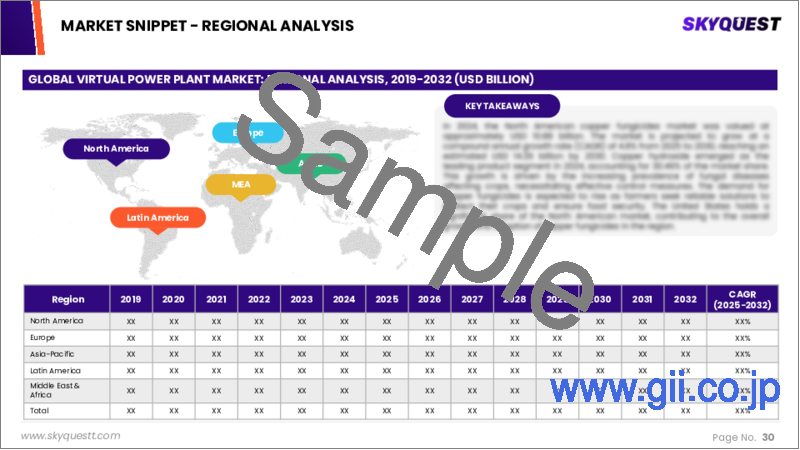|
|
市場調査レポート
商品コード
1614812
仮想発電所の市場規模、シェア、成長分析、技術別、提供別、ソース別、業界別、地域別 - 産業予測、2024~2031年Virtual Power Plant Market Size, Share, Growth Analysis, By Technology (Demand Response, Supply Side), By Offering (Hardware, Software), By Source (Renewable Energy, Storage), By Vertical (Commercial, Industrial), By Region - Industry Forecast 2024-2031 |
||||||
|
|||||||
| 仮想発電所の市場規模、シェア、成長分析、技術別、提供別、ソース別、業界別、地域別 - 産業予測、2024~2031年 |
|
出版日: 2024年12月12日
発行: SkyQuest
ページ情報: 英文 182 Pages
納期: 3~5営業日
|
全表示
- 概要
- 目次
仮想発電所の世界市場規模は、2022年に64億7,000万米ドルと評価され、2023年の72億9,000万米ドルから2031年には190億5,000万米ドルに成長し、予測期間(2024-2031年)のCAGRは12.8%で成長する見通しです。
世界の仮想発電所(VPP)市場は、クリーンで持続可能なエネルギーオプションに対する需要の高まりに後押しされ、力強い成長軌道に乗っています。主な促進要因としては、再生可能エネルギー源の統合の増加、政府の支援策、デジタル技術の進歩などが挙げられます。集中型電力網から分散型電力網への移行、信頼性の高い電力源に対する電力需要の高まり、エネルギー貯蔵とグリッドの柔軟性の重視により、市場の見通しはさらに高まっています。VPPはエネルギー需要のピークを管理するのに役立ち、ユーザーが余剰エネルギーをバッテリーなどの機器に蓄えることを可能にするため、その採用は増加すると思われます。さらに、政府によるインセンティブや顧客参加型プログラムが新たな収益源を生み出し、将来のエネルギー情勢におけるVPPの役割を確固たるものにしようとしています。
目次
イントロダクション
- 調査の目的
- 調査範囲
- 定義
調査手法
- 情報調達
- 二次データと一次データの方法
- 市場規模予測
- 市場の前提条件と制限
エグゼクティブサマリー
- 世界市場の見通し
- 供給と需要の動向分析
- セグメント別機会分析
市場力学と見通し
- 市場概要
- 市場規模
- 市場力学
- 促進要因と機会
- 抑制要因と課題
- ポーター分析と影響
- 競争企業間の敵対関係
- 代替品の脅威
- 買い手の交渉力
- 新規参入業者の脅威
- 供給企業の交渉力
主な市場の考察
- 重要成功要因
- 競合の程度
- 主な投資機会
- 市場エコシステム
- 市場の魅力指数(2023年)
- PESTEL分析
- マクロ経済指標
- バリューチェーン分析
- 価格分析
- 技術の進歩
- 規制情勢
- ケーススタディ
仮想発電所市場規模:技術別
- 需要応答
- 供給側
- 混合資産
仮想発電所市場規模:提供別
- ハードウェア
- ソフトウェア
- サービス
仮想発電所市場規模:ソース別
- 再生可能エネルギー
- ストレージ
- コージェネレーション
仮想発電所市場規模:業界別
- 商業用
- 産業用
- 住宅用
仮想発電所市場規模:地域別
- 北米
- 米国
- カナダ
- 欧州
- 英国
- ドイツ
- スペイン
- フランス
- イタリア
- その他欧州地域
- アジア太平洋
- 中国
- インド
- 日本
- 韓国
- その他アジア太平洋地域
- ラテンアメリカ
- ブラジル
- その他ラテンアメリカ地域
- 中東およびアフリカ
- GCC諸国
- 南アフリカ
- その他中東・アフリカ
競合情報
- 上位5社の比較
- 主要企業の市場ポジショニング(2023年)
- 主な市場企業が採用した戦略
- 市場の最近の動向
- 企業の市場シェア分析(2023年)
- 主要企業の企業プロファイル
- 会社概要
- 製品ポートフォリオ分析
- セグメント別シェア分析
- 収益の前年比比較(2021-2023)
主要企業プロファイル
- ABB
- Siemens
- General Electric
- AGL Energy
- Schneider Electric
- Enel X
- Cisco Systems, Inc.
- Bosch
- IBM
- Hitachi, Ltd.
- Mitsubishi Heavy Industries
- Next Kraftwerke
- AutoGrid Systems, Inc.
- Blue Pillar, Inc.
- Tesla Inc.
- Engie SA
- E.ON SE
- Ormat Technologies Inc
- Flexitricity Limited
- Toshiba corporation
結論と推奨事項
Global Virtual Power Plant Market size was valued at USD 6.47 billion in 2022 and is poised to grow from USD 7.29 billion in 2023 to USD 19.05 billion by 2031, growing at a CAGR of 12.8% in the forecast period (2024-2031).
The global virtual power plant (VPP) market is on a strong growth trajectory, fueled by the escalating demand for clean and sustainable energy options. Key drivers include increased integration of renewable energy sources, supportive government initiatives, and advancements in digital technology. The transition from centralized to distributed electricity grids, rising electricity demand for reliable sources, and emphasis on energy storage and grid flexibility have further enhanced market prospects. As VPPs help manage peak energy demands and allow users to store excess energy in devices like batteries, their adoption is set to rise. Additionally, government incentives and customer engagement programs are poised to create new revenue streams, solidifying the VPP's role in the future energy landscape.
Top-down and bottom-up approaches were used to estimate and validate the size of the Global Virtual Power Plant market and to estimate the size of various other dependent submarkets. The research methodology used to estimate the market size includes the following details: The key players in the market were identified through secondary research, and their market shares in the respective regions were determined through primary and secondary research. This entire procedure includes the study of the annual and financial reports of the top market players and extensive interviews for key insights from industry leaders such as CEOs, VPs, directors, and marketing executives. All percentage shares split, and breakdowns were determined using secondary sources and verified through Primary sources. All possible parameters that affect the markets covered in this research study have been accounted for, viewed in extensive detail, verified through primary research, and analyzed to get the final quantitative and qualitative data.
Global Virtual Power Plant Market Segmental Analysis
Global Virtual Power Plant Market is segmented by Technology, by Offering, by Source, by Vertical and by Region. Based on Technology, the market is segmented into Demand Response, Supply Side, Mixed Asset. Based on Offering, the virtual power plant market is segmented into Hardware, Software, Services. Based on Source, the market is segmented into Renewable Energy, Storage, Cogeneration. Based on Vertical, the virtual power plant market is segmented into Commercial, Industrial, Residential. Based on region, the market is segmented into North America, Europe, Asia Pacific, Latin America and Middle East & Africa.
Driver of the Global Virtual Power Plant Market
The virtual power plant market is experiencing significant growth, primarily driven by the escalating demand for renewable energy. As nations and organizations around the globe prioritize the transition to clean and sustainable energy sources, they are establishing ambitious renewable energy targets and promoting the incorporation of these resources into existing power grids. Virtual power plants play a crucial role in this transformation by facilitating the effective integration and management of distributed renewable sources, including solar and wind energy. This capability not only enhances grid reliability but also supports the broader objective of achieving a low-carbon energy future, underscoring the market's importance in the current energy landscape.
Restraints in the Global Virtual Power Plant Market
The global virtual power plant market faces significant restraints, with one of the most prominent being the substantial initial investment required for infrastructure and technology deployment. Establishing distributed energy resources, energy management systems, and necessary communication networks demands considerable upfront expenditures. This financial barrier can deter potential adopters, particularly in areas with constrained budgets or where the prospects for return on investment are ambiguous. As a result, these high entry costs may slow the growth of the virtual power plant market, making it challenging for stakeholders to justify the financial commitment necessary to implement such advanced energy solutions.
Market Trends of the Global Virtual Power Plant Market
The Global Virtual Power Plant market is witnessing a prominent trend characterized by the heightened integration of energy storage systems, significantly enhancing operational performance and flexibility. As energy storage technologies, particularly batteries, become more cost-effective and advanced, they are increasingly deployed within virtual power plants to optimize renewable energy management. These systems facilitate efficient energy usage by storing excess generation during low-demand periods and releasing it during peak times, improving grid support through services like frequency regulation and peak shaving. This integration not only bolsters grid resilience but also meets the rising demand for sustainable energy solutions, underscoring the evolving landscape of the energy sector.
Table of Contents
Introduction
- Objectives of the Study
- Scope of the Report
- Definitions
Research Methodology
- Information Procurement
- Secondary & Primary Data Methods
- Market Size Estimation
- Market Assumptions & Limitations
Executive Summary
- Global Market Outlook
- Supply & Demand Trend Analysis
- Segmental Opportunity Analysis
Market Dynamics & Outlook
- Market Overview
- Market Size
- Market Dynamics
- Driver & Opportunities
- Restraints & Challenges
- Porters Analysis & Impact
- Competitive rivalry
- Threat of substitute
- Bargaining power of buyers
- Threat of new entrants
- Bargaining power of suppliers
Key Market Insights
- Key Success Factors
- Degree of Competition
- Top Investment Pockets
- Market Ecosystem
- Market Attractiveness Index, 2023
- PESTEL Analysis
- Macro-Economic Indicators
- Value Chain Analysis
- Pricing Analysis
- Technological Advancement
- Regulatory Landscape
- Case Studies
Global Virtual Power Plant Market Size by Technology & CAGR (2024-2031)
- Demand Response
- Supply Side
- Mixed Asset
Global Virtual Power Plant Market Size by Offering & CAGR (2024-2031)
- Hardware
- Software
- Services
Global Virtual Power Plant Market Size by Source & CAGR (2024-2031)
- Renewable Energy
- Storage
- Cogeneration
Global Virtual Power Plant Market Size byVertical & CAGR (2024-2031)
- Commercial
- Industrial
- Residential
Global Virtual Power Plant Market Size by Region & CAGR (2024-2031)
- North America (by Technology, by Offering, by Source, by Vertical)
- US
- Canada
- Europe (by Technology, by Offering, by Source, by Vertical)
- UK
- Germany
- Spain
- France
- Italy
- Rest of Europe
- Asia-Pacific (by Technology, by Offering, by Source, by Vertical)
- China
- India
- Japan
- South Korea
- Rest of Asia Pacific
- Latin America (by Technology, by Offering, by Source, by Vertical)
- Brazil
- Rest of Latin America
- Middle East & Africa (by Technology, by Offering, by Source, by Vertical)
- GCC Countries
- South Africa
- Rest of Middle East & Africa
Competitive Intelligence
- Top 5 Player Comparison
- Market Positioning of Key Players, 2023
- Strategies Adopted by Key Market Players
- Recent Developments in the Market
- Company Market Share Analysis, 2023
- Company Profiles of All Key Players
- Company Details
- Product Portfolio Analysis
- Company's Segmental Share Analysis
- Revenue Y-O-Y Comparison (2021-2023)
Key Company Profiles
- ABB
- Company Overview
- Business Segment Overview
- Financial Updates
- Key Developments
- Siemens
- Company Overview
- Business Segment Overview
- Financial Updates
- Key Developments
- General Electric
- Company Overview
- Business Segment Overview
- Financial Updates
- Key Developments
- AGL Energy
- Company Overview
- Business Segment Overview
- Financial Updates
- Key Developments
- Schneider Electric
- Company Overview
- Business Segment Overview
- Financial Updates
- Key Developments
- Enel X
- Company Overview
- Business Segment Overview
- Financial Updates
- Key Developments
- Cisco Systems, Inc.
- Company Overview
- Business Segment Overview
- Financial Updates
- Key Developments
- Bosch
- Company Overview
- Business Segment Overview
- Financial Updates
- Key Developments
- IBM
- Company Overview
- Business Segment Overview
- Financial Updates
- Key Developments
- Hitachi, Ltd.
- Company Overview
- Business Segment Overview
- Financial Updates
- Key Developments
- Mitsubishi Heavy Industries
- Company Overview
- Business Segment Overview
- Financial Updates
- Key Developments
- Next Kraftwerke
- Company Overview
- Business Segment Overview
- Financial Updates
- Key Developments
- AutoGrid Systems, Inc.
- Company Overview
- Business Segment Overview
- Financial Updates
- Key Developments
- Blue Pillar, Inc.
- Company Overview
- Business Segment Overview
- Financial Updates
- Key Developments
- Tesla Inc.
- Company Overview
- Business Segment Overview
- Financial Updates
- Key Developments
- Engie SA
- Company Overview
- Business Segment Overview
- Financial Updates
- Key Developments
- E.ON SE
- Company Overview
- Business Segment Overview
- Financial Updates
- Key Developments
- Ormat Technologies Inc
- Company Overview
- Business Segment Overview
- Financial Updates
- Key Developments
- Flexitricity Limited
- Company Overview
- Business Segment Overview
- Financial Updates
- Key Developments
- Toshiba corporation
- Company Overview
- Business Segment Overview
- Financial Updates
- Key Developments





